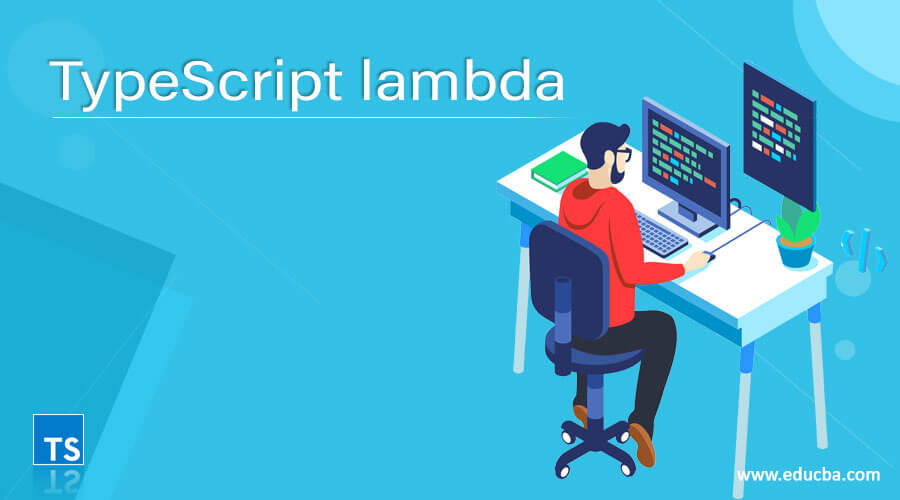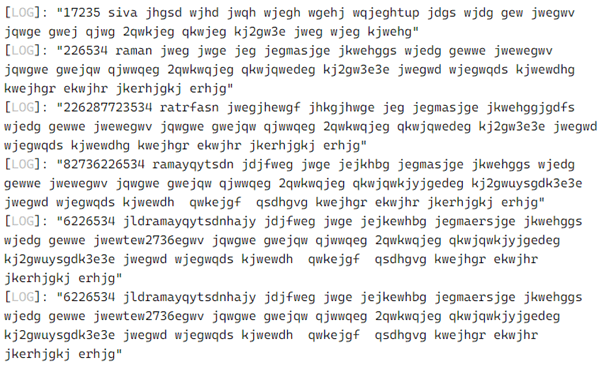Updated April 6, 2023
Introduction to TypeScript lambda
The Typescript lambda is one of the function is also known as anonymous function; it deploys the lambda expressions by using this arrow function it has the lexical type of scoping mainly typescript deployed the lambda expression by using some external services like AWS(Amazon Web Services) with the help of sdks(Software development toolkits) the lambda function of the typescript mostly used the angular brackets<> and the function will be initialized and implement using the curly brackets {} open and close function the arrow function(=>) is to be implementing the code and while we used angular brackets in the function it can be used to passing the parameters in the script.
Syntax:
The Typescript lambda function has mainly been used and implanted in the typescript for reducing the script code lines. With the help of the (=>) arrow symbol, the lambda function is implemented in the typescript.
class classname{
constructor()
{
--some codes—
}
functionname = () => ---some typescript logic codes---
}
var variablename = new classname();
variablename.functionname();The above codes are the basic syntax for creating and utilizing the lambda function with the help of arrow symbols or operators. We used the function in different ways of the typescript is also applicable for javascript technology.
How does the lambda function work in TypeScript?
The lambda function is used to reduce the lines of codes in the application; also, the time complexity is less when compared to other pre-defined functions. It has other names called Anonymous function it can be accepted with standard inputs and return with the output results which is required and depends based on the user inputs on both compile and run-time codes. Sometimes the typescript accepts both named and unnamed(anonymous) function also; it has default classes, modules, pre-defined function, and namespaces. While we are using the function in the script, it has accepted both argument and non-argument type parameters based on the user requirements; the parameter value will be null, undefined type of values are using the code in some time, then the default compiler will validate the parameter values which is declared by the specific user the compiler assumes that these specific parameters are the only parameters that will be passed to the particular function the number of arguments mentioned in the function will be matching to the number of parameters then the function expects the behavior of the application.
Basically, the parameter is optional in one of the scripting languages. We used additional default APIs like Rest api used in the node packages for executing the web-based application, which is implementing on the typescript code; the npm package must be installed on the server then it executes the API Rest based service architecture. If the function is invoked, then the lambda runs automatically using the handler mechanism. If the specific handler exists or returns some responsibility for the specific handle, it calls another handler.
Examples of TypeScript lambda
Here are the following examples mention below
Example #1
Code:
class demo {
id: number;
names: string;
city: string;
constructor(id: number, names: string, city:string) {
this.names = names;
this.id = id;
this.city=city;
}
show = () => console.log(this.id +' ' + this.names + '' + this.city);
}
let vars = new demo(17235, 'siva jhgsd wjhd jwqh wjegh wgehj wqjegh', 'tup jdgs wjdg gew jwegwv jqwge gwej qjwg 2qwkjeg qkwjeg kj2gw3e jweg wjeg kjwehg');
vars.show();
let vars1 = new demo(226534, 'raman jweg jwge jeg jeg', 'masjge jkwehggs wjedg gewwe jwewegwv jqwgwe gwejqw qjwwqeg 2qwkwqjeg qkwjqwedeg kj2gw3e3e jwegwd wjegwqds kjwewdhg kwejhgr ekwjhr jkerhjgkj erhjg');
vars1.show();
let vars2 = new demo(226287723534, 'ratrfasn jwegjhewgf jhkgjhwge jeg jeg', 'masjge jkwehggjgdfs wjedg gewwe jwewegwv jqwgwe gwejqw qjwwqeg 2qwkwqjeg qkwjqwedeg kj2gw3e3e jwegwd wjegwqds kjwewdhg kwejhgr ekwjhr jkerhjgkj erhjg');
vars2.show();
let vars3 = new demo(82736226534, 'ramayqytsdn jdjfweg jwge jejkhbg jeg', 'masjge jkwehggs wjedg gewwe jwewegwv jqwgwe gwejqw qjwwqeg 2qwkwqjeg qkwjqwkjyjgedeg kj2gwuysgdk3e3e jwegwd wjegwqds kjwewdh qwkejgf qsdhgvg kwejhgr ekwjhr jkerhjgkj erhjg');
vars3.show();
var vars4 = new demo(6226534, 'jldramayqytsdnhajy jdjfweg jwge jejkewhbg jeg', 'maersjge jkwehggs wjedg gewwe jwewtew2736egwv jqwgwe gwejqw qjwwqeg 2qwkwqjeg qkwjqwkjyjgedeg kj2gwuysgdk3e3e jwegwd wjegwqds kjwewdh qwkejgf qsdhgvg kwejhgr ekwjhr jkerhjgkj erhjg');
vars4.show();
var vars5 = new demo(736226534, 'ghdskramayqytsdn jdjfweg jwge jejkhbg jeg', 'm34reasjge jkwehggs wjedg gewwe jwewegwv jq864rgfhwgwe gwejqw qjwwqeg 2qwkwqjeg qkwjqwkjyjgedeg kj2gwuysgdk3e3e jwegwd784t wjegwqds kjwewdh qwkejgf qsdhgvg kwejhgr ekwjhr jkerhjgkj erhjg');
vars4.show();Output:
In the above example, we used lambda expression(=>) operator is used to implement the anonymous function that is the function with no name; it can perform some operations based on the requirements. That function will be called by using the class instance here; we used class with the constructor it accepts both parameter and non-parameter in the script. The anonymous function will print the values on the user output console screen.
Example #2
Code:
let vars = ['sjgsjdv', 'limjhgdvit jhwgd', 'exjhdbvuberant', 'destdsructuiwhiown','eouyewgulitwde', 'dspwdresqwent', 'dhgciw']
const first = vars.filter( (vars1, vars2, vars3 ) => {
vars3[vars2+1] +=' jhkug'
return vars1.length < 9
})
console.log(first)
vars = ['sjgsjdv', 'limjhgdvit jhwgd', 'exjhdbvuberant', 'destdsructuiwhiown','eouyewgulitwde', 'dspwdresqwent', 'dhgciw']
const seconds = vars.filter( (vars1, vars2, vars3) => {
vars3.push('sgdv')
return vars1.length < 9
})
console.log(seconds)
vars = ['sjgsjdv', 'limjhgdvit jhwgd', 'exjhdbvuberant', 'destdsructuiwhiown','eouyewgulitwde', 'dspwdresqwent', 'dhgciw']
const outputs = vars.filter( (vars1, vars2, vars3) => {
vars3.pop()
return vars1.length < 9
})
console.log(outputs)Output:
In the second example, we used lambda expression with additional methods like filter and arrays push and pop methods; these methods are performed the data operations to add and remove the values in the memory.
Example #3
Code:
var inputs = function(first:number,second:string) {
return first + second;
};
console.log(inputs(2356,"3"))Output:
In the final example, we used the basic anonymous function with the parameters here; we did not use the arrow symbols. The inputs are the variable reference, and also it acts as the anonymous function for this concatenation operations. We can combine the number and string values by using this function and print it on the output console.
Conclusion
The Typescript lambda is one of the features and functionality for performing the user tasks on the specific requirements. By using this feature, we can reduce the script code lines and the execution time also less when compared to other in-built functions. It will check and validate the codes in the compile-time itself, reducing the programmers’ complexity.
Recommended Articles
We hope that this EDUCBA information on “TypeScript lambda” was beneficial to you. You can view EDUCBA’s recommended articles for more information.





